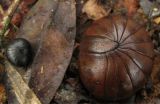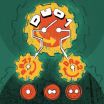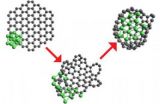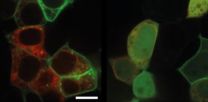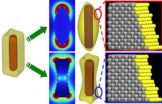(Press-News.org) JACKSONVILLE, Fla. — June 6, 3014 — An optical blood oxygen sensor attached to an endoscope is able to identify pancreatic cancer in patients via a simple lendoscopic procedure, according to researchers at Mayo Clinic in Florida.
The study, published in GIE: Gastrointestinal Endoscopy, shows that the device, which acts like the well-known clothespin-type finger clip used to measure blood oxygen in patients, has a sensitivity of 92 percent and a specificity of 86 percent.
MULTIMEDIA ALERT: Video and audio are available for download on the Mayo Clinic News Network.
That means, of 100 patients with pancreatic cancer, this sensor would detect 92 of them, based on the findings. And of 100 patients who don't have pancreatic cancer, the test would correctly identify them 86 percent of the time.
The device measures changes in blood flow in the tissues that are in the proximity to the pancreas, under the theory that tumors change the flow of blood flow in surrounding tissues because the tumors need oxygen to grow. The endoscope is passed into the stomach and the duodenum, where the measurements are taken. The pancreas lies just outside the duodenum.
"Although this is a small pilot study, the outcome is very promising. There is no test now available that can accurately identify pancreatic cancer at an early stage, short of removing some of the organ," says the study's senior investigator and gastroenterologist Michael Wallace, M.D., M.P.H. "We need new ways to detect pancreatic cancer effectively, and simply, as early as possible."
Now, more than 90 percent of pancreatic cancers are discovered at an advanced or metastatic stage with no effective therapy available. That explains why pancreatic cancer is the fourth most common cause of cancer deaths in the U.S., although it ranks 10th in occurrence.
"We are now confirming our findings in a much larger study, involving institutions in the U.S. and in Europe," Dr. Wallace says.
The technique is a very different way of looking at cancer detection, he says.
"What is quite unusual is that we were trying to sense changes that are not in the tumor itself but are in the nearby, normal-appearing tissues," he says. "It relies on a principle, now being increasingly acknowledged, called a cancer field effect. Instead of looking for the needle in the haystack, we now look at the haystack to see how it is different when there's a needle inside.
"The general concept is that cancers cause surrounding tissue to undergo changes in the flow of oxygen that are detectable, not visually or even under the microscope, but by this kind of sensor," Dr. Wallace says.
To test the ability of the sensor to recognize pancreatic cancer, researchers studied two groups — one in which 14 patients were already diagnosed with the cancer, and another in 10 cancer-free patients.
Dr. Wallace says the blood sensor endoscope is also being tested in colon and esophageal cancers.
INFORMATION:
The study was funded by National Institutes of Health and National Cancer Institute, as well as the Mayo Clinic Foundation for Medical Education and Research.
About Mayo Clinic
Recognizing 150 years of serving humanity in 2014, Mayo Clinic is a nonprofit worldwide leader in medical care, research and education for people from all walks of life. For more information, visit 150years.mayoclinic.org, MayoClinic.org or newsnetwork.mayoclinic.org/.
Endoscope with an oxygen sensor detects pancreatic cancer
Providing hope for earlier detection, Mayo Clinic says
2014-06-06
ELSE PRESS RELEASES FROM THIS DATE:
Magnetic moment of the proton measured with unprecedented precision
2014-06-06
One of the biggest riddles in physics is the apparent imbalance between matter and antimatter in our universe. To date, there is no explanation as to why matter and antimatter failed to completely annihilate one another immediately after the big bang and how the surplus matter was created that went on to form the universe as we know it. Experiments conducted at Johannes Gutenberg University Mainz (JGU) have contributed towards a resolution of this problem. For the first time a direct and high-precision measurement of the magnetic moment of the proton has been conducted ...
A new way to make laser-like beams using 250x less power
2014-06-06
ANN ARBOR – With precarious particles called polaritons that straddle the worlds of light and matter, University of Michigan researchers have demonstrated a new, practical and potentially more efficient way to make a coherent laser-like beam.
They have made what's believed to be the first polariton laser that is fueled by electrical current as opposed to light, and also works at room temperature, rather than way below zero.
Those attributes make the device the most real-world ready of the handful of polariton lasers ever developed. It represents a milestone like none ...
New species of ancient chirping giant pill-millipedes from Madagascar already threatened
2014-06-06
An international team of researchers comprised of Thomas Wesener, Museum Koenig, Bonn, Daniel Le, Field Museum, Chicago and Stephanie Loria, American Museum of Natural History, New York, discovered seven new species of chirping giant pill-millipedes on Madagascar. The study was published in the open access journal ZooKeys.
The species discovered all belong to the genus Sphaeromimus, which is Latin for 'small ball animal'. However, the designation 'small' is not always true for the members of the genus as one of the newly discovered species surprises with a size larger ...
Probiotics prevent deadly complications of liver disease
2014-06-06
Bethesda, MD (June 6, 2014) — Probiotics are effective in preventing hepatic encephalopathy in patients with cirrhosis of the liver, according to a new study in Clinical Gastroenterology and Hepatology, the official clinical practice journal of the American Gastroenterological Association. Hepatic encephalopathy is a deterioration of brain function that is a serious complication of liver disease.
"This rigorous new research finds that probiotics modify the gut microbiota to prevent hepatic encephalopathy in patients with cirrhosis of the liver," said David W. Victor III, ...
Shatterproof screens that save smartphones
2014-06-06
University of Akron polymer scientists have developed a transparent electrode that could change the face of smartphones, literally, by making their displays shatterproof.
In a recently published scientific paper, researchers demonstrated how a transparent layer of electrodes on a polymer surface could be extraordinarily tough and flexible, withstanding repeated scotch tape peeling and bending tests. This could revolutionize and replace conventional touchscreens, according to Yu Zhu, UA assistant professor of polymer science. Currently used coatings made of indium tin ...
Breakthrough study solves plant sex mystery
2014-06-06
A team of biologists from the University of Leicester has solved a mystery surrounding how plants have sex.
The researchers have discovered a pair of proteins made by flowering plants that are vital for the production of the sperm present within each pollen grain.
Scientists already knew that flowering plants, in contrast to animals, require not one, but two sperm cells for successful fertilisation: one to join with the egg cell to produce the embryo and one to join with a second cell to produce the nutrient-rich endosperm inside the seed.
The mystery of this 'double ...
Method of nickel-carbon heterofullerenes synthesis presented
2014-06-06
Scientists from several British, Spanish and Russian research centers (MIPT, Institute for Spectroscopy RAS, Kurchatov Institute and Kintech Lab Ltd) have come up with a method of synthesizing a new type of nickel-carbon compound. The article titled Formation of nickel-carbon heterofullerenes under electron irradiation has been published by Dalton Transactions and is available as a pre-print at arxiv.org. The first author of the article is Alexander Sinitsa, an MIPT student, and the leading author is Andrey Popov (Institute for Spectroscopy RAS, 1989 MIPT graduate).
Heterofullerenes ...
Mitochondrial DNA of first Near Eastern farmers is sequenced for the first time
2014-06-06
The mitochondrial DNA of the first Near Eastern farmers has been sequenced for the first time. In the research, published in the journal PLOS Genetics, experts analysed samples from three sites located in the birthplace of Neolithic agricultural practices: the Middle Euphrates basin and the oasis of Damascus, located in today's Syria and date at about 8,000 BC.
The paper is signed by Daniel Turbón and Alejandro Pérez Pérez, from the Department of Animal Biology of the University of Barcelona (UB); Eva Fernández, from Liverpool John Moores University; Cristina Gamba, Eduardo ...
Herpesviruses undercover
2014-06-06
This news release is available in German.
The Kaposi's sarcoma-associated herpesvirus (KSHV), a gammaherpesvirus that can cause multiple forms of cancer, establishes lifelong infections within the body. To do so the virus has to find a way to modulate the immune system of its host.
„Intruders are usually fought off immediately by an antiviral immune response that is triggered by sensors including the toll-like receptors (TLR)," says HZI researcher Dr. Kendra Bussey, author of the study that was published in the "Journal of Virology". Toll-like receptors detect ...
Opening a wide window on the nano-world of surface catalysis
2014-06-06
Surface catalysts are notoriously difficult to study mechanistically, but scientists at the University of South Carolina and Rice University have shown how to get real-time reaction information from Ag nanocatalysts that have long frustrated attempts to describe their kinetic behavior in detail.
The key to the team's success was bridging a size gap that had represented a wide chasm to researchers in the past. To be effective as nanocatalysts, noble metals such as Au, Pt, Pd and Ag typically must be nanoparticles smaller than 5 nm, says Hui Wang, an assistant professor ...
LAST 30 PRESS RELEASES:
Whooping cough vaccination for pregnant women strengthens babies’ immune system
Dramatic decline in new cases of orphanhood in Uganda driven by HIV treatment and prevention programs
Stopping weight loss drugs linked to weight regain and reversal of heart health markers
Higher intake of food preservatives linked to increased cancer risk
Mass General Brigham–developed cholera vaccine completes phase 1 trial
First experimental validation of a “150-year-old chemical common sense” direct visualization of the molecular structural changes in the ultrafast anthracene [4+4] photocycloaddition reaction
Lack of support for people on weight loss drugs leaves them vulnerable to nutritional deficiencies, say experts
Dogs’ dinners can have greater climate impact than owners’
Are you ready to swap salmon for sprats and sardines?
1.6 million UK adults used weight loss drugs in past year
American College of Cardiology comments on new dietary guidelines for Americans
American Society of Gene & Cell Therapy and Orphan Therapeutics Accelerator partner to advance and commercialize promising rare disease treatments
One in 14 patients having day case surgery have new or worse chronic pain 3 months after their operation
New study highlights link between eviction rates and gun violence
Heatwaves heat up soil but not toxin levels in rice, study finds
Digital modeling reveals where construction carbon emissions really come from
Turning farm waste into water filters
New study shows how the spleen helps the immune system accept a transplant
New Mayo Clinic study advances personalized prostate cancer education with an EHR-integrated AI agent
Researchers identify novel therapeutic target to improve recovery after nerve injury
Microbes in breast milk help populate infant gut microbiomes
Reprogramming immunity to rewrite the story of Type 1 diabetes
New tool narrows the search for ideal material structures
Artificial saliva containing sugarcane protein helps protect the teeth of patients with head and neck cancer
Understanding the role of linear ubiquitination in T-tubule biogenesis
Researchers identify urban atmosphere as primary reservoir of microplastics
World’s oldest arrow poison – 60,000-year-old traces reveal early advanced hunting techniques
Bristol scientists discover early sponges were soft
New study uncovers how rice viruses manipulate plant defenses to protect insect vectors
NSF–DOE Vera C. Rubin Observatory spots record-breaking asteroid in pre-survey observations
[Press-News.org] Endoscope with an oxygen sensor detects pancreatic cancerProviding hope for earlier detection, Mayo Clinic says

